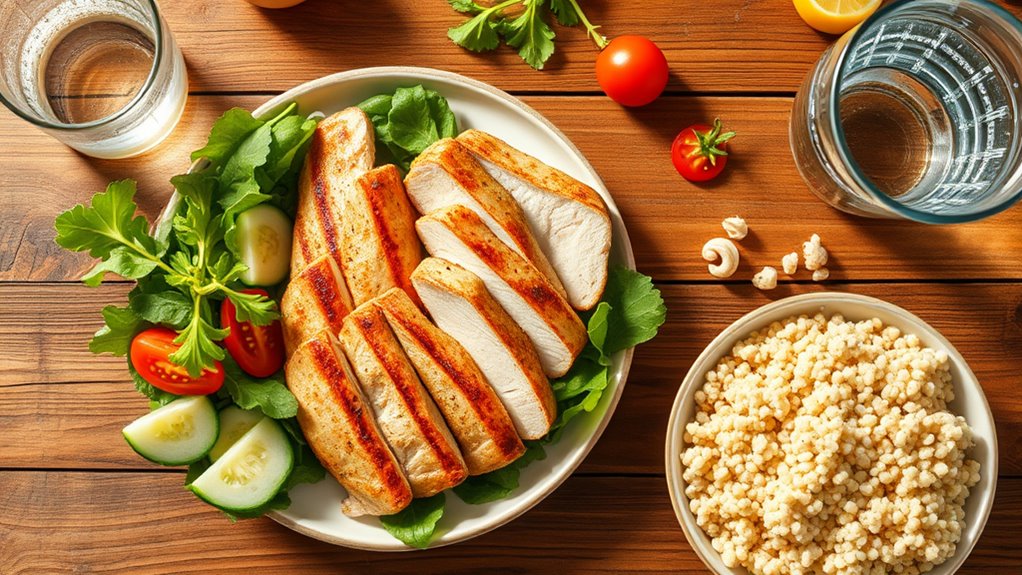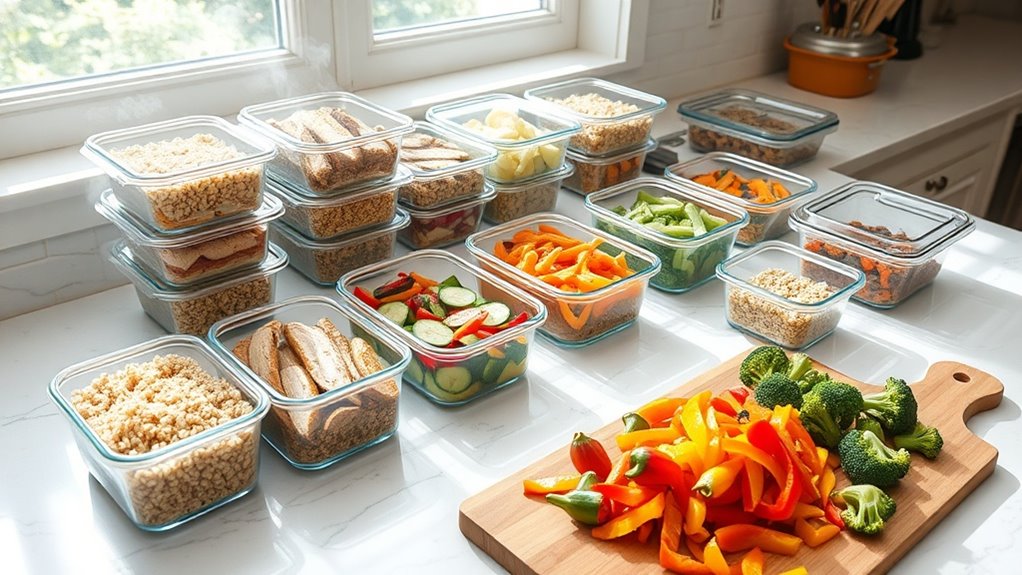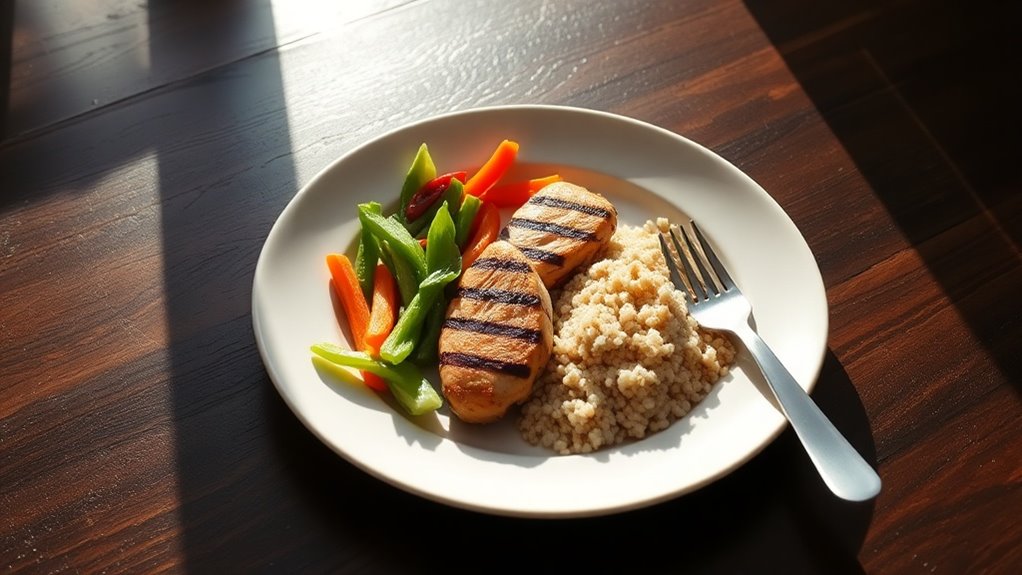My Go-To Fat Loss Meal Plan for Busy Days
It’s quite a coincidence that your jam-packed schedule aligns with a streamlined fat loss meal plan designed for efficiency. You’ll build energy with quick, nutrient-dense options like protein smoothies, while keeping portions in check to avoid overeating. Imagine how these tweaks could transform your routine and help you hit your goals.
Quick Breakfast Options
Because mornings are hectic, you’ll want breakfast options that are fast to prepare while supporting fat loss goals.
In your fat loss meal plan for busy people, opt for high-protein choices like Greek yogurt with berries, which you can assemble in under two minutes and provide satiety to curb cravings.
A quick egg white omelet with veggies offers essential nutrients and helps maintain muscle during calorie control, backed by studies showing protein aids fat loss.
Blend a smoothie with spinach, protein powder, and almond milk for a portable option that balances macros without spiking blood sugar.
Keep portions controlled for steady energy. Additionally, incorporating mindful eating practices can enhance your meal satisfaction and help regulate your hunger cues throughout the day.
Efficient Lunch Ideas
For your midday meal, efficient lunch ideas keep things simple and effective for fat loss on busy days.
These options emphasize high-protein, fiber-rich foods to boost metabolism and control hunger, backed by studies showing their role in reducing calorie intake. You’ll prepare them quickly with minimal ingredients, ensuring balanced nutrition without sacrificing flavor.
-
Grilled chicken salad: Pair lean protein with veggies for satiety; it’s evidence-based for preserving muscle during cuts.
-
Veggie-packed wrap: Use whole grains and greens for fiber, aiding digestion and steady energy as per nutrition research.
-
Tuna and avocado mix: Offers healthy fats and omega-3s, promoting fat oxidation while keeping prep under 5 minutes. Incorporating smart food substitutions can further enhance your meals without compromising your favorite flavors.
Simple Dinner Recipes
As you wrap up your busy day, you’ll appreciate simple dinner recipes that support fat loss without demanding much time.
Start with quick chicken dinners, easy veggie stir-fries, and fast protein salads, which provide balanced nutrients to keep you satisfied and energized. These options draw on evidence from nutrition studies showing that high-protein, veggie-rich meals enhance metabolism and portion control. Incorporating whole, unprocessed foods into your dinners can further improve satisfaction and help you manage caloric intake effectively.
Quick Chicken Dinners
When you’re juggling a packed schedule, quick chicken dinners provide a straightforward way to fuel your fat loss goals without sacrificing flavor or nutrition.
These meals leverage lean protein to boost metabolism and promote satiety, helping you stay on track with calorie control. They’re simple to whip up with everyday ingredients, supporting balanced eating.
-
Grill marinated chicken breasts with herbs for a protein-packed, under-300-calorie option that aids muscle preservation.
-
Bake seasoned thighs in the oven for a moist, flavorful dish that delivers essential amino acids without added fats.
-
Add spices like turmeric for anti-inflammatory benefits, enhancing meals while keeping them low in sodium and high in satisfaction.
Easy Veggie Stir-Fry
Easy veggie stir-fries build on quick chicken dinners by offering another speedy, nutrient-rich option for your fat loss goals.
You’ll prepare one in under 15 minutes using fresh vegetables like broccoli, bell peppers, and spinach, which provide fiber and vitamins to curb hunger without excess calories.
Stir-fry them in a non-stick pan with a dash of olive oil and herbs for flavor, keeping portions controlled.
This method supports sustainable weight management by boosting metabolism through nutrient density, as studies show veggies enhance satiety.
It’s versatile, fitting your busy schedule while maintaining balance in your diet.
Fast Protein Salads
Fast protein salads offer a quick, satisfying dinner option that packs in muscle-building nutrients to support your fat loss journey.
You’ll whip up these meals in under 15 minutes using lean proteins and fresh veggies, keeping calories in check while boosting metabolism.
-
Choose lean proteins: Opt for grilled chicken, tuna, or tofu to provide essential amino acids that preserve muscle during cuts, backed by studies showing higher protein intake aids fat loss.
-
Incorporate veggies: Add spinach, cucumbers, and tomatoes for fiber and micronutrients, promoting fullness without excess calories, as research links veggie-rich diets to better weight management.
-
Enhance with healthy fats: Include avocado or nuts for sustained energy, balancing the meal to prevent hunger, per evidence from nutrition science.
Healthy Snack Suggestions
Although busy days often leave little room for meal prep, healthy snacks can play a key role in your fat loss journey by stabilizing blood sugar and curbing overeating.
Opt for nutrient-dense options like a handful of almonds, which provide healthy fats and protein to keep you satisfied. Greek yogurt with berries offers probiotics and fiber, aiding digestion while controlling hunger.
Veggies such as carrots with hummus deliver vitamins and steady energy without spiking insulin.
Remember, portion control matters; aim for 150-200 calories per snack to maintain balance and support your goals effectively. Incorporating high-fiber and high-protein foods in your snacks will further enhance satiety and aid in weight loss.
Stay consistent for best results.
Meal Prep Strategies
As you juggle a demanding schedule, effective meal prep strategies help you maintain a fat loss plan without sacrificing nutrition. By dedicating a few hours weekly, you’ll streamline your routine, ensuring meals are ready and aligned with your calorie goals, backed by studies showing prepped eaters achieve better adherence.
-
Batch cook proteins and veggies: Prepare large quantities of lean meats, eggs, and greens in advance to control portions and reduce daily cooking time, promoting consistent energy levels.
-
Focus on simple assembly*: Chop ingredients ahead for quick meals like salads or stir-fries, minimizing waste and supporting *sustained fat loss through variety.
-
Incorporate timing tools*: Use containers with compartments to *portion meals accurately, helping you avoid overeating while keeping flavors fresh and meals enjoyable. Additionally, meal planning acts as a roadmap for your weight loss journey, keeping you on track and reducing stress associated with meal decisions.
Grocery Essentials
To build a fat loss meal plan that fits your busy schedule, you stock up on key proteins like chicken, eggs, and legumes for muscle repair and satiety.
Fresh veggies such as spinach, broccoli, and peppers provide essential vitamins and fiber to keep your energy steady without excess calories.
Balancing these staples ensures your meals are nutritious, easy to prepare, and effective for sustainable weight management. Incorporating healthy fats like avocados and nuts can further enhance fat-burning and overall meal satisfaction.
Key Proteins
When building your grocery list for a fat loss meal plan, prioritize these five key proteins: lean poultry, fish, eggs, legumes, and low-fat dairy.
They’re essential for maintaining muscle while cutting calories, as studies show high-protein intake boosts metabolism and satiety. Choose options that fit your routine for easy prep.
-
Lean poultry, like chicken breast, provides about 25g of protein per 100g with low fat, helping preserve lean mass during deficits.
-
Fish, such as tuna or salmon, supplies omega-3s that reduce inflammation and support heart health alongside fat loss.
-
Eggs deliver complete proteins with all essential amino acids, making them a versatile, budget-friendly staple for quick meals.
Fresh Veggies
Fresh vegetables round out your grocery essentials for a fat loss meal plan, offering low-calorie options packed with fiber and nutrients that enhance satiety and support weight management, as studies link higher veggie intake to better metabolic health.
You’ll want to stock up on versatile picks like spinach, broccoli, bell peppers, and carrots, which you can easily add to salads, stir-fries, or snacks. Choose seasonal varieties for freshness and affordability; aim for at least five servings daily to boost fiber intake, aiding digestion and curbing cravings, per nutrition research.
Balance your plate by pairing veggies with proteins for sustained energy without excess calories.
Tracking and Adjusting Your Plan
Once you’ve implemented your fat loss meal plan, tracking your progress becomes essential to ensure it works for you. Regularly log your weight, measurements, and energy levels using simple tools like apps or a journal. This evidence-based approach lets you spot trends and make tweaks for better results.
-
Weigh in weekly: Compare against baselines to assess fat loss without daily fluctuations.
-
Monitor nutrition logs: Track calories and macros to identify imbalances, drawing from dietary studies.
-
Evaluate energy and mood: If fatigue sets in, adjust portions or add variety for sustainability.
Incorporating food journaling into your routine can further enhance accountability and mindfulness in your eating habits.
If needed, refine your plan based on data, maintaining a balanced caloric deficit for long-term success.





